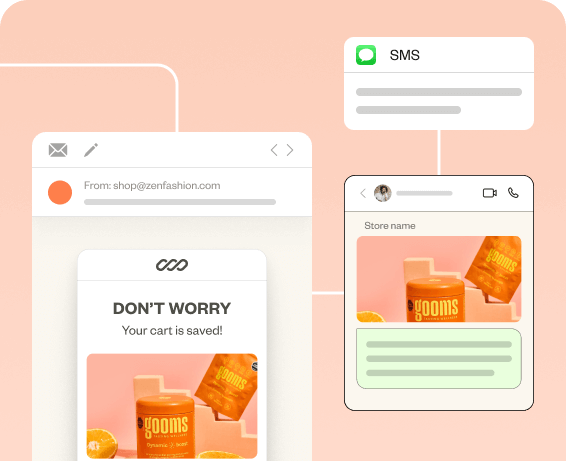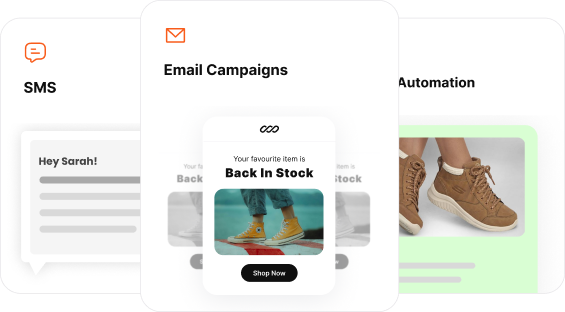You check your dashboard and see millions in revenue, but the number that keeps you up at night is the 70% of shoppers who leave without buying. This isn’t just a feeling; according to extensive research by the Baymard Institute, the average cart abandonment rate is a staggering 70.19%. With rising ad costs, every lost sale feels more painful. You’ve spent a fortune on ads to get them to your store, only for them to bounce at the last second. It’s one of the biggest challenges for store owners, but you can reduce cart abandonment with the right approach.
The reason for this disconnect is that customer expectations have fundamentally changed. Shoppers trained by tools like ChatGPT now expect instant, helpful, and personalized answers. According to a new report from Zoovu, 71% of shoppers want Generative AI woven into their buying experience. This post breaks down the key findings from Zoovu’s “2026 Benchmark for AI in Ecommerce Conversion” report, which analyzed over 3 million real-world shopper interactions. We’ll give you actionable takeaways to improve your store’s conversion rate.
TL;DR: Key Insights from the Report
- AI Boosts Sales: Shoppers who engage with AI-powered assistance are 25% more likely to convert, a key goal of any effective email marketing strategy.
- It’s About Answers, Not Browsing: Over 70% of shopper queries focus on product validation—like compatibility, usage, or specs—showing they use AI to build buying confidence anda trust.
- The “Help Me” Framework: Successful brands use AI to assist customers at four key moments: finding, choosing, learning, and bundling products.
The Big Shift: How AI Has Permanently Changed Shopper Expectations
For years, e-commerce has relied on static filters and keyword searches. Customers had to scroll through endless product grids and open multiple tabs to compare options. This creates friction and decision fatigue, leading directly to shopping cart abandonment. As research from Shopify points out, a complicated checkout process is a top reason for abandonment.
Generative AI has created a new standard. Shoppers no longer just type keywords; they ask full questions. The Zoovu report notes that search queries are now 4x longer than before, signaling a massive shift from simple keywords to natural language questions that effective e-commerce email marketing must address. This has created an “expectation gap” where shoppers want a helpful, conversational guide, but most stores still offer a silent, static catalog. Closing this gap is the new frontier for improving AI in ecommerce conversion.
Customers now expect your store to:
- Understand their intent: Not just what they type, but what they mean.
- Provide instant answers: No more digging through FAQ pages.
- Offer personalized guidance: Recommend products based on their specific needs.
If your site can’t deliver this, you’re not just losing a sale; you’re losing every dollar you invested, highlighting the importance of retention marketing to maximize customer lifetime value.
What the Data Reveals: 3 Million Interactions Prove AI Drives Conversions
Grounded in a massive dataset of real shopper behavior, Zoovu’s report provides clear benchmarks for how AI impacts the path to purchase. The findings show what happens when real customers engage with AI on leading retail sites.report-2026-benchmark-ai-in-ecommerce-conversion.pdf
| Metric | Impact of AI-Powered Assistance |
| Conversion Rate | +25% increase in purchase likelihood |
| Click-Through Rate | +40% increase to the next step in the journey |
| Content Personalization | Up to +40% conversion lift with benefit-led content |
| Average Order Value | Up to +65% AOV increase with smart bundling |
1. AI-Assisted Shopping Directly Increases Conversion
This is the most critical takeaway. The data shows a direct, measurable link between AI interaction and sales, which is the ultimate goal of what email marketing is all about. A 25% lift in conversions isn’t a small number. For a store doing $500,000 in annual revenue, successfully engaging even a fraction of shoppers with AI could mean tens of thousands of dollars in recovered sales.
- Shoppers who used an AI assistant were 40% more likely to click through to the next step.
- Most importantly, those shoppers were 25% more likely to complete a purchase.
- It wasn’t just a novelty; 71% of users rated the AI’s responses as “helpful,” proving that shoppers find genuine utility in these tools.
2. Shoppers Use AI for Validation, Not Just Discovery
Buyers use AI to make a final decision with confidence. The report found that the majority of questions were about product validation, a crucial part of avoiding common email marketing mistakes that fail to address customer concerns.
- Over 50% of questions were about product specifications.
- Another 38% focused on usage guidance, with top questions being “What is the battery life?” and “Can I use this outdoors?”.
This aligns with industry analysis from BigCommerce, which emphasizes AI’s role in transforming the business landscape by meeting these new demands. When a shopper asks a validation question, they are on the verge of buying. Answering it instantly removes the last barrier to purchase.
3. Contextual Content is a Conversion Superpower
One-size-fits-all product descriptions are no longer enough. The report found that tailoring content based on what a shopper values has a massive impact. For example, instead of just listing “16GB RAM,” explain that it means “smooth performance for gaming and multitasking.”
- Translating technical specs into real-world benefits boosted conversions by up to 40%.report-2026-benchmark-ai-in-ecommerce-conversion.pdf
- Personalizing descriptions to a shopper’s use case increased click-through rates by 29-43%.
The “Help Me” Framework: 4 Ways to Boost AI in Ecommerce Conversion
The report outlines a four-stage framework that successful brands use to guide customers toward a purchase. Instead of leaving shoppers alone, AI can proactively assist at each step. This approach is validated by firms like Gartner, which predict that customer-centricity driven by AI will be essential for competitiveness.
| Stage | Customer Need | AI-Powered Solution |
| Help Me Find | Discover relevant products quickly. | Conversational search that understands intent. |
| Help Me Choose | Compare options and clarify value. | Guided selling flows and dynamic recommendations. |
| Help Me Learn | Get quick answers to final questions. | On-page, contextual Q&A bots. |
| Help Me Bundle | Find compatible add-ons. | Smart, automated bundling and configurators. |
Step 1: Help Me Find
A shopper lands on your site with a need, but often a vague one. They want to find matching products without getting lost.
- The Old Way: Static search bars that fail on misspellings and broad filters that overwhelm users.
- The AI-Powered Way: Conversational search that understands natural language. As seen with Lucky Bike, this can generate dynamic questions to guide a user from “a bike” to “the perfect mountain bike for trail riding,” resulting in a 50% lift in search click-throughs.
Step 2: Help Me Choose
The shopper has a few options but is stuck. They need help comparing and understanding which is the best fit for them.
- The Old Way: Forcing users to open multiple tabs and compare confusing spec sheets side-by-side.
- The AI-Powered Way: Guided selling flows that ask what matters most. Officeworks used this for a laptop finder, asking about needs like gaming or work, which increased click-through by 19% by delivering tailored recommendations.
Step 3: Help Me Learn
The customer is on the product page and ready to buy but has one last question.
- The Old Way: Making them hunt for an FAQ page or leave your site to search Reddit for an answer.
- The AI-Powered Way: An on-page AI assistant that provides instant, contextual answers. Staples did this for tech products, answering questions about compatibility and features directly on the page, boosting conversions by 25%. This is a prime example of leveraging AI in ecommerce conversion.
Step 4: Help Me Bundle
The customer is at checkout but wonders if they need anything else to go with their purchase.
- The Old Way: A generic “related products” carousel that often shows irrelevant items.
- The AI-Powered Way: Smart bundling logic that understands compatibility. Bosch used AI to recommend the right accessories for power tools and appliances, leading to a massive 65% increase in Average Order Value (AOV).
Your Next Step: From Conversion to Retention
As the Zoovu report makes clear, AI-powered discovery is essential for winning the initial conversion. By guiding shoppers to the right products with confidence, brands like Microsoft and Bosch are dramatically reducing friction and boosting sales. A customer who had a seamless, helpful buying experience is far more likely to trust your brand in the future.
However, the customer journey doesn’t end at the first purchase. The real profit is in turning that hard-won customer into a loyal, repeat buyer.
Just as on-site AI helps guide the initial purchase, the right automation platform is key to continuing that personalized conversation post-purchase. This is where post-purchase emails and omnichannel marketing become critical. Using email automation allows you to engage customers at the right moment without manual effort.
Ready to turn new buyers into lifelong fans? Retainful makes it simple to automate personalized email, SMS, and WhatsApp messages that keep customers engaged. You can use our platform to recover abandoned carts , send thank you notes using proven ecommerce email templates , and deliver targeted offers—all on autopilot.
Frequently Asked Questions
AI in e-commerce uses technologies like machine learning to create a smarter shopping experience. This includes personalized recommendations, conversational search, and chatbots to guide shoppers and answer questions instantly.
AI boosts conversions by giving shoppers instant answers and personalized guidance, which builds their confidence to buy. According to Zoovu’s report, this can increase the likelihood of conversion by 25%.
Traditional search needs exact keywords to work. AI-powered search understands natural language, so it can answer complex questions and interpret what a shopper really means, leading to better product discovery.
Yes, especially on product pages. Data shows over 70% of AI interactions are for quick product questions about specs or usage. A chatbot can provide these answers instantly, preventing shoppers from leaving your site.
Start with your product detail pages. Adding a simple AI-powered Q&A tool to answer common product questions can quickly build customer confidence and directly impact your conversion rate by addressing last-minute concerns.
Not necessarily. While custom enterprise solutions can be costly, platforms like Retainful are making automation and personalization accessible. Furthermore, many modern e-commerce platforms are integrating AI features, allowing smaller stores to leverage this technology without a massive upfront investment.


